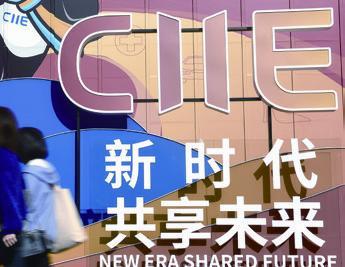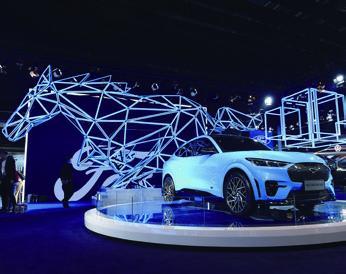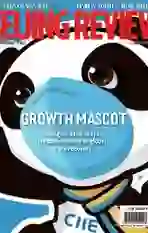A SUCCESS BEYOND EXPECTATIONS
2020-11-20ByThomasScott-Bell
By Thomas Scott-Bell


As I hurtled toward Shanghai on Chinas famous high-speed rail to cover the Third China International Import Expo (CIIE), I made it my mission to answer one simple question: Is the CIIE still relevant in 2020?
Having attended the expo last year for the fi rst time, I had already witnessed fi rsthand the worth of hosting and participating in such an event.
For one, at its core, the CIIE is a genuine business platform. Whether it be large enterprises already established in the Chinese market, smaller unknown businesses making their first waves into it, or buyers from China looking for the next “big”international product or service, participating in the CIIE is a serious way of increasing company profits and boosting trade. At last years event alone, deals worth $71.13 billion were signed, making it hard to disagree that the CIIE had vast money-making potential.
I had also observed the non-commercial rewards that the event presented. As an international event, the CIIE offered an excellent environment for companies and government offi cials to build contacts with their Chinese counterparts. As corny as it sounds, these people-to-people exchanges made the expo stand out from other trade shows, with national booths and thousands of products from participating countries and regions helping bring both Chinese and international cultures and stories closer together.
But sitting in my seat as Chinas everchanging landscape whizzed by me at 300 km per hour, I wondered whether there was still a market for such an international trade event given the year 2020 has been.
COVID-19 uncertainties
The effect of the coronavirus pandemic hung heavily over these concerns. Despite China having controlled the pandemic within its borders, the virus neverending spread across Europe, North and South Americas and parts of Asia had me pessimistic that the event could be as successful as before. I worried that exhibitors would be unable to travel, products would be diffi cult to import safely, and as a result, the serious business and people-to-people exchanges that have defined the event would be diminished.
Coupled with my fear of empty booths was also the feeling that the changing political environment over the past 12 months is no longer crying out for global trade events such as this. Although 2019 was not a golden year for international cooperation by any means, 2020—fueled in part by the coronavirus—has seen attitudes toward international trade lose enthusiasm at an unprecedented rate. Once a way of bringing countries together, global trade has become a political football, often ridiculed as some governments call for greater deglobalization, a return to self-suffi ciency and for supply chains to be brought home.
Even in China, the governments latest economic directive—dual circulation—has suggested a greater focus on utilizing its own markets, and as such sparked fears that it is no longer concerned with creating opportunities for international businesses in its markets.
But as I made my way to the fi rst pavilion on the opening day of the expo, passing the many variations of Jinbao the Panda—the offi cial mascot of the CIIE—as I went, those fears started to disappear.
A thumbs-up
For anyone who has hosted a party, sound is an easy method of gauging success. Quiet muffl ing means you might be about to hit a dud, while high decibel means youve got something good on your hands. Thankfully for the CIIE, the place was rocking!
As I toured the expos four main halls—each one showcasing a different theme—I took in the sounds, the colors and the excitement that was being generated by the innovative products on display; an electric Mustang from Ford, Abbotts first artificial heart, a table tennis-playing robot from Japanese tech company Omron, the worlds largest black diamond—it was safe to say the event had lost none of its sparkle.
Aspects that I had worried would harm the event actually revealed themselves to be great possibilities for the thousands of companies attending. Dual circulation—the policy some academics have labeled as“China First” and a threat to international companies prospects in the Chinese market—was in fact being discussed as an“excellent opportunity,” with one government official from Europe commenting that the policy could open doors for their companies.
Fears that the coronavirus would have a negative effect on proceedings were also unfounded, with the CIIE receiving more than 400,000 visitors looking at the thousands of exhibitors products. One food and drinks company from Spain I spoke to could not believe the enthusiasm they were getting for their product, with another having to stop himself from being taken to a buyers store, such was the excitement for his product.

Social distancing was enforced by the thousands of volunteers who gave up their time to help, but this did not stop fruitful discussions nor limit prospects for cultural exchanges. One sit-down with a consultant and former diplomat from Benin in West Africa was as much about potential trade with China as it was about the intricate meaning behind the fabulous national dress he was wearing.
And far from the coronavirus diminishing the CIIE, one foreign government representative who attended the event last year told me the virus had in fact improved this years event. As I looked at her surprised, she quickly explained that the strict safety measures put in place—such as mandatory tests for all visitors to ensure a coronavirus-free atmosphere—meant only“real business people” were attending, and as such, this expanded the possibility of exhibitors finding potential buyers for their products.
The coronavirus had also helped create a new niche for the expo in terms of companies attending and services offered by the organizers. One such service was linking CEOs who could not attend with reporters via virtual press conferences, and it was during such a conference with a representative from United Overseas Bank in Singapore that I understood just why companies wanted to attend the CIIE, and how upset they were by their absence.
It was also a poignant—and slightly surreal moment—being near Pfizers booth as news came through of their coronavirus vaccines effectiveness. Along with other positive trials currently underway by British pharmaceutical AstraZeneca and Chinese medicine manufacturer Sinovac, it meant the expo finished on a note of optimism that there is light at the end of the tunnel in the worlds fight against the coronavirus.
On the final day of the expo news also filtered through of the financial deals made during the expo. Despite the pandemic and the uncertainties it has created for the global market, the Third CIIE reported intended deals worth $72.62 billion, an increase of 2.1 percent from the previous year, a sign of the confidence and interest international companies have in the Chinese market.
At the start of my journey to Shanghai I had asked myself whether such an event was still relevant in 2020. As the figures from this years event show, and the enthusiasm I witnessed from the businesses that attended, the answer has to be a resounding yes.

